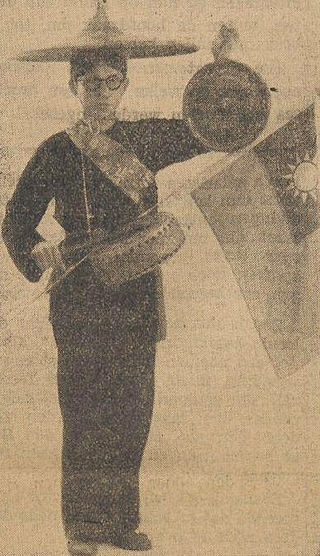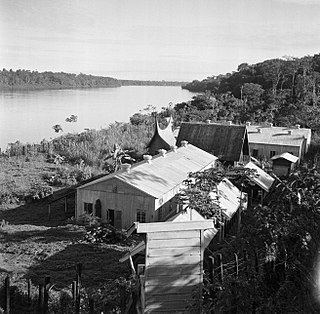
Boven-Digoel, often simply called Digoel, was a Dutch concentration camp for political detainees operated in the Dutch East Indies from 1927 to 1947. The Dutch used it to detain thousands of Indonesians, most of whom were members of the Communist Party of Indonesia (PKI), Indonesian nationalists, and their families. It was located in a remote area on the banks of the river Digul, in what is now Boven Digoel Regency in South Papua, Indonesia. The camp was originally opened to exiled communists after the failed 1926 uprisings in Java and Sumatra; at its largest extent in 1930 it held around 1300 internees and 700 family members.

The Colony of Curaçao and Dependencies was a Dutch colony in the Caribbean Sea from 1634 until 1828 and from 1845 until 1954. Between 1936 and 1948, the area was officially known as the Territory of Curaçao, and after 1948 as the Netherlands Antilles. With the proclamation of the Charter for the Kingdom of the Netherlands on 15 December 1954, the Netherlands Antilles attained equal status with the Netherlands proper and Suriname in the new Kingdom of the Netherlands.

Jean Pierre Moquette moved from the Netherlands to Java in 1873. He worked as a bookkeeper at the sugar plantation and factory 'Kremboeng', in Sidoarjo near Surabaya. He was also a stamp and coin dealer in Surabaya. He became known for the alterations of stamps and postal stationery. Besides philately, numismatics and his bookkeeping work in the sugar business, he was a researcher in the field of sugar cane. For his research of cane sowing and crossing he was in 1898 appointed Officer of the Order of Orange-Nassau. In 1900 he founded the Indonesian Numismatic Cabinet in which he was active as curator. In the early 1900s he did ethnographic and historical research for which in 1924 he was appointed correspondent for the Royal Netherlands Academy of Arts and Sciences in Amsterdam.
Jacobus Anthonie Meessen was a Dutch photographer who took more than 250 portraits and landscapes of the Dutch East Indies between 1864 and 1870. Born to a carpenter in Utrecht, Meessen worked in that trade in the Indies before marrying in the Netherlands in the early 1860s. He returned to the colony in 1864, intent on documenting its land and people. He worked mostly in the capital of Batavia, Java, and Padang, Sumatra; he also photographed Bangka, Belitung, Borneo, and Nias.

Louis Victor Wijnhamer, better known as Pah Wongso, was an Indo social worker popular within the ethnic Chinese community of the Dutch East Indies, and subsequently Indonesia. Educated in Semarang and Surabaya, Pah Wongso began his social work in the early 1930s, using traditional arts such as wayang golek to promote such causes as monogamy and abstinence. By 1938, he had established a school for the poor, and was raising money for the Red Cross to send aid to China.

Frans Friedrich Ludwig Ulrich Last was a Dutch jurist who served as Attorney General at the Supreme Court of the Dutch East Indies.
Jacobus Rudolph Razoux Kühr, commonly known as J. R. Razoux Kühr or Jack Razoux Kühr was an Indo civil servant and businessman from the Dutch East Indies largely remembered for being one of the first editors of the popular Chinese Indonesian newspaper Sin Po.

Aliarcham (c.1901-1933) was a Sarekat Islam and Indonesian Communist Party party leader, activist and theoretician in the Dutch East Indies. He was a major figure behind the PKI's turn to more radical policies in the mid-1920s. He was arrested by Dutch authorities in 1925 and exiled to the Boven-Digoel concentration camp, where he died in 1933. He became a well-known Martyr, especially among Communists and Indonesian nationalists.

Jodensavanne was a Dutch internment camp for political prisoners from the Dutch East Indies operated in Surinam during World War II. The camp was named after a nearby, long-abandoned Jewish colony, Jodensavanne.
Soetitah was a Sarekat Islam and Communist Party of Indonesia (PKI) propagandist, activist, and schoolteacher in Semarang, Dutch East Indies in the 1910s and 1920s. She was a close ally of Semaun, Tan Malaka, and other Semarang communists of the time and was chair of the women's section of the party in the early 1920s. She was exiled by the Dutch to the Boven-Digoel concentration camp from 1927 to 1930.

Copieweg camp was a Dutch Internment Camp for German civilians that operated in Surinam during World War II, from 1940 to 1947. They were interned due to their nationality rather than due to proven support for Nazi Germany, although some of them were widely known to be Nazi supporters. Non-German detainees were also sent to this camp after 1942, including a small group of South African conscientious objectors and a few members of the Surinam political opposition including the politician Wim Bos Verschuur. The camp was built on the site of a Roman Catholic Monastery twenty kilometres from Paramaribo which was expanded to house a larger number of detainees.
Moenasiah was a Sarekat Islam and Indonesian Communist Party leader active in Semarang, Central Java, Dutch East Indies during the 1920s. She was chairperson of the women's section of the Communist Party for a time in the 1920s. She was exiled by Dutch authorities to Boven-Digoel concentration camp from 1927 to 1930.

Soekaesih was a Communist Party of Indonesia activist known for being one of only a handful of female political prisoners exiled by the Netherlands government to Boven-Digoel concentration camp. After being released she traveled to the Netherlands in the late 1930s and campaigned for the camp to be shut down.

Abdoe'lxarim M. S., who was born Abdoel Karim bin Moehamad Soetan, was a journalist and a Communist Party of Indonesia leader. He was interned in Boven-Digoel concentration camp from 1927 to 1932. During World War II, he collaborated with the Japanese and became an important figure in recruiting support for them in Sumatra; after their defeat he then became a key figure in the anti-Dutch republican forces during the Indonesian National Revolution.

Kho Tjoen Wan, sometimes spelled Kho Tjoen Gwan, was a Chinese Indonesian journalist, writer and political activist active mainly from the 1910s to the 1930s in the Dutch East Indies. He was involved with the Communist Party of Indonesia in the 1920s and may have been its first ethnically Chinese executive member.
Urbanus Pardede was an Indonesian Communist and newspaper editor from Sumatra, active both in the Dutch East Indies and independence eras. During the years 1926–30, Dutch authorities arrested him without charge because of his Communist activities and exiled him to the Boven-Digoel concentration camp. He was also a key figure in the East Sumatra revolution of 1946 and became bupati of Simalungan Regency in the early independence era.
Paiso was an Indonesian communist activist and political prisoner who was imprisoned by the Dutch in the Boven-Digoel concentration camp from 1927 to 1932. His son-in-law Manai Sophiaan (1915-2003) was an Indonesian diplomat and politician and his grandson Sophan Sophiaan (1944-2008) was an actor and politician.

Ignatius Franciscus Michael Salim, born Abdul Chalid Salim, was an Indonesian journalist, communist activist and political prisoner. He was imprisoned without trial by the Dutch in the Boven-Digoel concentration camp from 1928 to 1943. He was the brother of Agus Salim and the cousin of Sutan Sjahrir. His book Fifteen Years in Boven Digoel was the only Dutch-language book about Digoel ever published by a former prisoner.
Fifteen Years in Boven Digoel: Concentration Camp in New Guinea is a 1973 Dutch-language memoir written by I. F. M. Salim, a former detainee in the Boven-Digoel concentration camp in New Guinea. It was the only Dutch-language book about Boven Digoel ever published by a former prisoner. Its Indonesian translation was published in 1977.

Laurens Theodorus "Theo" Becking (1887–1945) was an officer in the Royal Netherlands East Indies Army. He was a key figure in the repression of the unsuccessful 1926 Communist Party of Indonesia uprising in Java and Sumatra. He planned and oversaw the construction of the Boven-Digoel concentration camp in New Guinea where many Communist Party members were exiled, and was its first administrator. During the 1930s, he was a prominent member of the fascist Nationaal-Socialistische Beweging and briefly became its leader in the Indies in 1939; because of that association, he was detained during the Second World War and eventually deported with NSB members to Jodensavanne internment camp in Surinam, where he died.
















